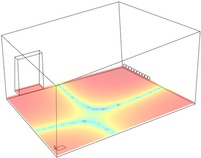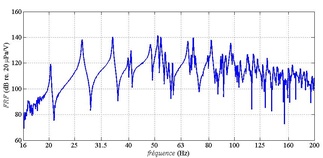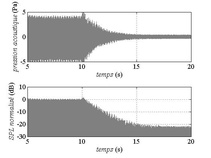CTI - INTERACTS
Funding source:
|
CTI |
Start: |
2012 |
End: |
2016 |
Sponsor: ![]()
Partners:
Full title: Intelligent low-frequeNcy acousTic Equalization of Rooms using Active ConTrol Subwoofers
The INTERACTS CTI-funded project is a technology transfer collaboration between EPFL, HEPIA (Geneva) as academic partners, and Goldmund SA (Geneva) and PSI Audio (Yverdon), two major companies in the professional audio industry.
Context
The occurence of low-frequency resonances in rooms devoted to sound diffusion degradates the audio rendering quality of the low frequency bound of the audible spectrum. This has several prejudical impacts:
- on the uneven spatial distribution of energy,
- on the degradation of musical timbres (spectral degradations)
- on the sustain of low-frequency tones (modal extinction time)
 |
 |
 |
|
spatial distribution of sound pressure levels in the reverberant chamber for mode (1,1,0) at 34,9 Hz |
frequency response of the reverberant chamber measured at one corner with a broadband noise source located at the same corner | time response of the room to a time-windowed pure sine at 34,9 Hz, measured at one corner (up: linear waveform; bottom: corresponding time-series in sound pressure levels) |
Examples: here are two versions of a musical excerpt:
- extracted from the original recording
- recorded in the reverberant chamber (better rendered with a subwoofer or good quality headphones)
Objectives
The aim of this project is to develop low-frequency sound absorbers, effective on a relatively broad frequency range (ideally 20 Hz - 200 Hz), allowing an efficient equalization of the room acoustics down to the low-frequency bound of the audible spectrum, for application to recording studios and home-audio/-cinema spaces.
Solution/Methodology
In this project, EPFL-LTS2 develops a dedicated broadband low-frequency sound absorber based on the principle of the electroacoustic resonator concept developped in the lab (EPFL thesis n°5331). The design methodology is the following:
- identify the frequency range of interest according to the room modal behavior and set the central frequency of the electroacoustic resonator
- identify a target acoustic impedance function to assign to the active electroacoustic resonator
- select loudspeakers according to a matching of resonance frequency and other passive properties (total losses, force factor)
- identify the electronic control law according to the target acoustic impedance function and the loudspeaker passive properties
- implement the control law on a digital signal processing platfrom (FPGA, DSP) combined with a voltage-controlled current amplifier (transconductance amplifier)
- test the performance in a standing wave duct (standard acoustic impedance measurement according to ISO-10534-2)
- test the overall performances in actual rooms
Outcomes of the project
- numerical model for the prediction of room modes damping
- identification of acoustic impedance targets and number/surface of active absorption as a functuin of the room properties in order to optimally set the electroacoustic absorbers
- set of active electroacoustic absorbers prototypes/demonstrators
- objective assessement in different rooms situations (reverberant chamber, listening rooms)
- perceptual evaluation of the overall performances with listening tests
Additional information
Status: ongoing (started on December 1, 2012 - end on November 30th, 2015)
Related publications:
- Karkar, S. et al., "Electroacoustic absorbers for the low-frequency modal equalization of a room: what is the optimal target impedance for maximum modal damping, depending on the total area of absorbers?", presented at Forum Acusticum 2014, Krakow, Poland, September 7-12, 2014.
- Lissek, H., "Absorbeurs électroacoustiques actifs: application à l’égalisation des salles aux basses fréquences", presented at the CIDB-GIAC-SFA colloquium "Vibrations et bruits basses fréquences dans les bâtiments", Paris, France, June 8-9, 2015.
- Lissek, H. et al., "Experimental assessment of active electroacoustic absorbers for broadband room modes damping", in the Proceedings of INTERNOISE 2015, San Francisco, USA, August 9-12 2015.